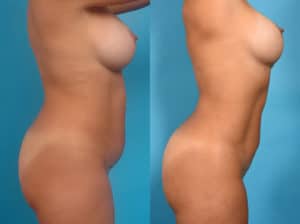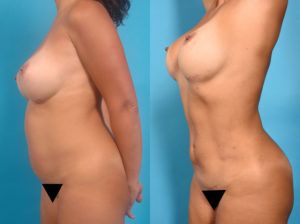*Individual results may vary
What is Liposuction?
Liposuction, originally described in the early 1970’s, is a cosmetic surgical procedure utilized to remove unwanted areas of fat from various areas of the body. The incision used is very small, about ¼ inch in size. A narrow, hollow metal tube called a cannula is inserted through this incision. The cannula is attached to a vacuum source which permits the removal of the fat and transfers it to a collection canister. The removal of this fat is designed to improve the contours of your body.*
The original version of liposuction used fairly thick cannulae, which easily caused “divots” in the skin surface. In 1985, the tumescent liposuction technique was described. In this procedure, liposuction is performed in two steps. For the first step, a very thin metal cannula is inserted in the skin incision. It is used to infiltrate (insert into the fat under the skin) saline (salt water) solution containing epinephrine. Epinephrine is a substance naturally produced in your adrenal glands that causes blood vessels in the fat to constrict tightly. This dramatically reduces the blood loss during the procedure to very little, allowing one to remove more fat safely.* If it is desired to perform the procedure under local anesthesia or with oral or intravenous sedation, lidocaine, a local anesthetic, can be mixed into the saline solution as well to numb the skin. The second step consists of inserting the cannula with suction applied to remove the fat.
In the 1990’s, ultrasound was used in an attempt to break up the fat and permit its more efficient removal. Ultrasound was applied externally to the skin, and even internally through the cannula just prior to the application of suction. Results were improved, but still not where we wanted to be. However, this was a breakthrough, as ultrasound energy is tissue specific for fat and will therefore assist in its breakdown and removal. More on this below.
Introducing VASER Liposuction
Your Guide To Liposuction Surgery
Want to learn more about Liposuction surgery? Download our free eBook, Dr. Epstein’s Guide to Selecting a Surgeon for Liposuction.
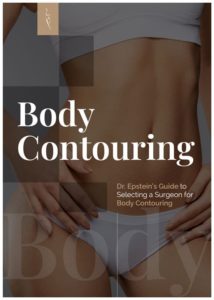
What is VASER Liposuction?
In the next decade, a new concept for the application of high energy internal ultrasound (VASER) was created. This is an alternative to the traditional, more physically traumatic technique of traditional liposuction. The VASER procedure is now performed in three steps instead of two. The first step is the same as before – infiltrating the fat with saline solution and epinephrine. The new step is the second step. A thin, solid titanium probe with one or more “rings” at the tip is inserted under the skin into the fat. The handle of the probe transmits high energy ultrasound which, due to the ringed design of the tip of probe, is concentrated and emitted from the tip of the probe. The probe is now directed by the surgeon into the unwanted fat.
Ultrasound energy is “tissue-specific” for fat, in other words, targets the fat only, leaving the nerves, blood vessels and muscle alone. Without damage to these other tissues, patients experience less discomfort and achieve much smoother results than with traditional liposuction.* The heat generated by the ultrasound gives some tissue tightening, which is a desirable benefit. When the ultrasound contacts the fat, it emulsifies, or liquefies, and separates from the rest of the fat. In the third step, a cannula is inserted under the skin through the same incision and the now “liquid” fat can be easily, and far less traumatically removed. Think of it as a “gentler, more efficient” form of liposuction.
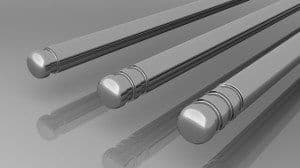
VASER probes of 1, 2 and 3 ring design used to emulsify fat.
For more information on the VASER®, please read “VASER – the latest technique in liposuction”.
Advantages of VASER Liposuction
While early liposuction was designed to de-bulk fat, it was not the most artistic procedure. It was great for large collections of fat such as in the outer thighs (“saddle bags”) the abdomen, and sometimes the inner thighs, but not much else. Contour deformities were not uncommon.
Using the much thinner probes and cannulae with the VASER system, the surgeon can now target the fat in the individual layers – superficial, intermediate and deep. When creating contours, it is not how much fat the surgeon removes that matters, it is what you leave behind that gives nice, youthful contours. So by targeting the fat in the individual layers of the skin more precisely and aesthetically, rather than just “de-bulking” fat, it can be removed in such a way that muscular definition can be achieved*.
Using the VASER system, the fat that is removed is still viable. In other words, the fat cells are still alive and therefore can be reinserted back into the body in areas that are deficient in volume, such as the buttocks and hips. This fat can even be inserted into the male pectoral, deltoid and biceps muscles to give the muscle greater bulk. It won’t make you stronger, but it can make a male look more muscular. Some women also request having the fat transferred to their breasts to add upper breast fullness and overall enlargement.
What is Power-Assisted Liposuction?
As discussed previously, during the process of removing fat, a thin metal tube called a “cannula” is used to remove the fat as the final step in the procedure. Just as VASER ultrasound energy is used to improve the efficiency of fat removal by way of emulsifying (liquifying) the fat, Power-Assisted Liposuction (PAL) is used to improve the efficiency of the extraction process. Traditionally, the surgeon holds the cannula in his dominant hand. The cannula is attached via a silicone rubber tube to a suction cannister. The surgeon moves the cannula back and forth through the subcutaneous fat. As the cannula is moved, the holes at the tip of the cannula remove the fat.
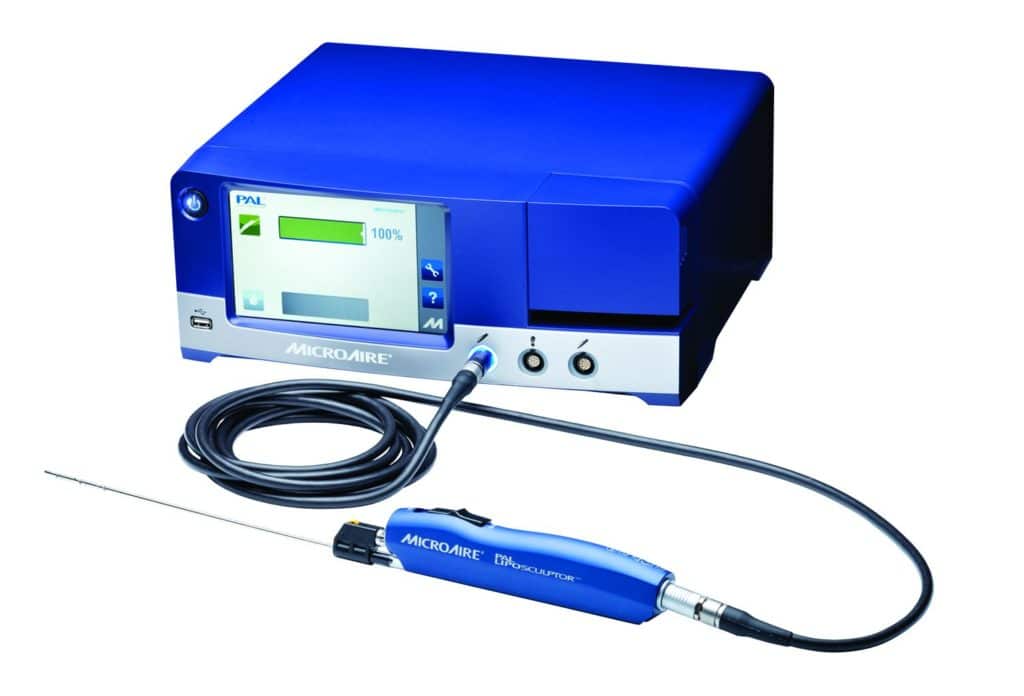
PAL is an improvement of this process. The cannula is mounted onto a handpiece which has a motor. The motor causes the cannula to reciprocate (move back and forth) rapidly but over a very short distance (a few millimeters). This results in several advantages:
- The cannula can move effortlessly through the fat, with little to no resistance
- The holes in the tip of the cannula are constantly moving across the fat, removing more of it
- It allows the surgeon to move back and forth very atraumatically, resulting in little to no bruising
- The fat is removed more evenly, resulting in far less “divots” and other contour deformities
- Improved ability to perform “etching” of lines of muscle definition
When I Perform Liposuction, I Use BOTH VASER To Liquify The Fat, AND PAL To Improve Efficiency Of Fat Removal. The Results When I Combine The Two Technologies Is Far Superior.
What is Liposculpture?
With the advent of the above techniques, the early procedure of liposuction, which just removed unwanted bulges of fat now is taken to a new level. Now we have a sophisticated system called “liposculpture” to yield artistic results! Liposculpture can remove excess fat as well as volume deficiencies from different levels of fat as well as add additional fat to create a more youthful, sculpted look. These techniques will yield much better results in patients of any age.* For the purpose of simplicity, in further discussion, when I use the term liposuction as I perform it, I am referring to liposculpture.
Let’s get this one myth out of the way quickly: Does the fat travel elsewhere? Absolutely not! The fat cells are removed.* If you do not watch your dietary intake, you can increase the size of the remaining fat cells and gain weight. However, if you maintain your weight, the fat cells removed by liposuction will not appear elsewhere in the body.
Ideal Candidates For Liposuction
The ideal candidate is healthy, not overweight (or maybe slightly so), and is concerned about one or more problem areas. Often these areas will not respond to diet or exercise. Patient expectations need to be realistic and you must understand that this procedure is not a substitute for a proper diet and regular exercise. It is instead used to improve the contours of your body.
Areas Commonly Treated with Liposuction
Some of the more commonly treated areas are:
- Abdomen
- Flanks
- Chest/Male breasts
- Back
- Hips
- Neck
- Buttocks
- Arms
- Thighs
- Calves
- Ankles
Can Liposuction be combined with other procedures?
This procedure may be performed alone, or in combination with other cosmetic surgical procedures. One of my favorite applications is to combine liposuction with an abdominoplasty/tummy tuck. Liposuction will thin and shape the abdominal skin, whereas the abdominoplasty will tighten the abdominal muscles and remove the excess skin. Each of the two procedures address a different problem, be it excess skin or excess fat. The result is a much shapelier and defined abdomen.* Just about any portion of the body with excess fat under the skin can be safely treated with VASER. In order to determine how much fat can be safely removed, a personal consultation is necessary. The goals remain, creating a slimmer, more shapely, and defined you.
It is a misconception to believe that a thin person is not a candidate for liposuction. A thin person may still have small isolated excesses of skin such as in the abdomen or outer thighs. Anyone may benefit from the improved definition that precisely targeted removal of small, medium and larger excesses of fat may bring.
The Liposuction Procedure – Day of Surgery
Prior to entering the operating room, with you in the standing position and the assistance of a long mirror for you to see, I will mark the problems areas with skin markers of several different colors. This information will assist me in determining how much fat to remove from the individual areas, as well as noting the areas that will receive fat transfer.
A nurse will escort you into the operating room, and you will lie down on the operating table. The anesthesiologist will start an intravenous line (IV), place monitoring EKG pads on your chest and you will begin to receive anesthesia: sedation or general anesthesia. Smaller areas can be performed with local anesthesia if you so desire.
Once you are under anesthesia, your skin is treated with antiseptic and sterile drapes placed, I will then mark specific areas for tiny incisions, approximately ¼ inch in length. These will be later used for the metal tubes, or cannulae, to pass into the skin to inject fluid and then remove the fat.
Next, a dilute solution of lidocaine and epinephrine will be injected into the fat through the tiny incisions made earlier. The amount of fluid given causes the skin and the fat to swell and become tense (tumesce), hence the name “tumescent technique”. By making the fat tense, it becomes easier to remove. The epinephrine permits fat removal with minimal or no blood loss.
When the VASER® is being used (most cases), a thin solid probe, about the thickness of the metal suction cannula (3-4 mm diameter), is introduced into the incisions. The ultrasound energy is turned on. This energy is emitted from the tip of the probe. Any fat that is in contact with the probe is emulsified (liquefied).
The last step involves inserting the hollow metal tube (cannula) into the incisions. The tube is connected to a suction line. The excess fat is removed. This fat can also be collected and re-injected into problem areas deficient in volume such as the buttocks, hips and/or breasts.
The wounds are sutured and dressed. In certain areas, a drain may be placed for 3-10 days. This helps evacuate excess fluid and hastens the time it takes you to recover. You are then transferred to the recovery room. Compression garments to reduce post-operative swelling may be applied at this time. As you recover, your nurse will tend to you and you alone. When you are ready for discharge, she will give verbal and written instructions to you and your caregiver who will be escorting you home.
VASER 4D Lipo And VASER Hi-Def
This technique is credited to it’s inventor, Alfredo Hoyos, MD, a plastic surgeon practicing in Bogota, Colombia.
Whereas traditional liposuction is all about improving body contour by removing excess deposits of fat, VASER Hi Def is a technique that uses the VASER ultrasound fat removal and PAL technology to sculpt the body. Excess fat may be removed from one area of excess, and grafted (transferred) into another area where there is a deficiency of volume. Yet other areas, not noticeably excessive in fat are further sculpted to enhance the natural contours and form.
Here is an example of one my VASER/PAL Hi-Definition body contouring surgeries:
While VASER Hi-Def took liposuction to a new level and introduced the ability to sculpt and etch definition during surgery, Hoyos was still not finished innovating. Consideration needed to be given to natural motion and underlying muscle anatomy, as well as accounting for future weight loss to enhance the final surgical result. The final product is a more sculpted, more natural and youthful body*. The beauty of these techniques is that they are applicable to both men and women.
Not completely satisfied with VASER Hi-Def, Hoyos created VASER 4D Lipo which takes Hi-Def to the next level: attention is paid to the placement and natural motion of the underlying musculature, as well as to account for future weight loss so as to enhance the quality of the result. The end result is a more sculpted you*. This technique is applicable to both men and women.
I was personally trained in these techniques by Dr. Hoyos at his surgical facility in Bogota, Colombia. I am fortunate to have not only the benefit of his expertise and skills, but also his ongoing friendship. After acquiring these exciting skills, I have been able to surgically create contours like never before imaginable! Offering these techniques to my patients represents my unending dedication to bring the latest technology and quality of care to my practice.
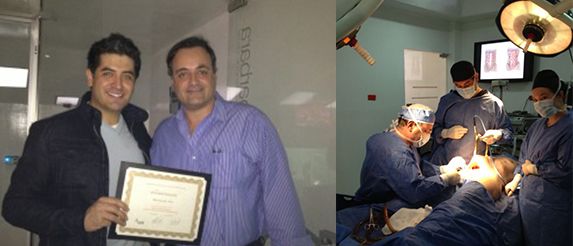
The above photos depict Dr. Hoyos and myself in surgery in Bogota, Colombia (February 2013) at the 4D Lipo course and receiving my certificate of completion of the course. I have since returned to work with Dr. Hoyos again in August 2018 to update myself on the latest techniques in liposculpture and body contouring.
Liposuction Recovery
After the liposuction procedure, patients will experience swelling, occasional bruising and discomfort in the treated area. Compression garments are usually used to help reduce these symptoms and reduce swelling. You may return to work when comfortable, and strenuous exercise may be resumed in about three weeks in most cases.
I will give you special postoperative instructions to facilitate your recovery and help you to get the best possible results. Final contours will not be visible until after swelling and bruising subside. This may take 4 -6 months, results will appear gradually during this time period*.
I have found it very helpful to begin postoperative massage therapy combining deep tissue massage, lymphatic drainage and external ultrasound to mobilize the fluids in your tissues, reduce swelling and maximize the visible results of your liposculpture. This can be performed by a physical therapist or a massage therapist. Every post op should start the day after surgery, massage every day for 1 week. Weeks 2-6 it’s every other day. After that becomes maintenance. Maintenance is usually up to 3-6 months and it’s 1-2 times a week, then 1-2 a month. It really depends on how the person is doing.
DR. EPSTEIN ANSWERS THE QUESTION PATIENTS ARE USUALLY TOO EMBARRASSED TO ASK: WHEN CAN I HAVE SEX AFTER MY PROCEDURE?
VASER Lipo Results
Your results can be long lasting if you maintain a healthy diet and exercise. One last thing – some believe that removed fat goes to other parts of the body – that is a total myth! Fat cells removed are gone forever. They do not multiply in adulthood. However, if you do not eat properly, they will enlarge! If you maintain a healthy lifestyle of proper diet and exercise, your results should last for years to come*. Normal aging changes will occur, and that will vary amongst individuals.
How much does Liposuction cost?
The cost will vary by the amount of areas that will be treated, as well as the amount of fat that is anticipated to be removed. A personal consultation is required to provide an exact quote.
Risks of Liposuction
Although liposuction is considered safe, there are certain risks associated with any type of procedure. Infection is very rare, but more common minor complications include small areas of fluid collection and minor contour deformities. Liposuction is one of the most commonly performed cosmetic procedures and is almost always performed with no serious complications.
You can minimize potential risks by choosing a surgeon experienced is this procedure as well as by following his/her pre and postoperative instructions. To learn more about the liposuction procedure, I encourage you to call my Long Island office today and schedule a consultation with me.
How Can I Prepare for My Liposuction Procedure?
Preparing ahead of time for your liposuction procedure can help prevent complications during your surgery and ensure a successful recovery. Before arriving at your liposuction procedure, we recommend patients do the following:
- Consult with your primary doctor about stopping any prescription medications that may interfere with the procedure.
- Get lab testing or a medical evaluation to ensure your body is in good enough health for a surgical procedure.
- Quit smoking at least six weeks before your surgery.
- Avoid anti-inflammatory medications that can increase bleeding.
- Arrange transportation with a loved one.
- Invest in comfortable, stretchy clothing.
- Prepare your home, especially your bedroom, for ease and comfort during recovery.
How Long Does Liposuction Take?
While the duration of the procedure can vary, depending on each patient’s overall goals, the average liposuction procedure will take between one to two areas. The size or total length of the area will also have an effect on the duration of your procedure. For example, liposuction in smaller areas of the body, such as the chin, may take as little as 30 minutes, whereas liposuction in larger areas, such as the abdomen, may take up to an hour or more.
Is Liposuction Covered By Insurance?
Unless your liposuction procedure is needed to address a certain medical condition, it is typically not covered by most insurance companies. Because liposuction is often a cosmetic surgery that enhances your overall appearance, most patients do have to fund their own procedures, but because of the long-lasting benefits of liposuction, many find that the investment is worthwhile.
How Long Do the Results of Liposuction Last?
The results of liposuction are permanent. Once skin and fat are removed from the area, there is no chance they will come back, so liposuction patients will be able to enjoy their results for a lifetime. However, because significant weight gain or loss will change your overall appearance, even after liposuction, having a healthy lifestyle is an essential part of maintaining your results.
Schedule A Consultation
For more information about the liposuction procedure, contact Epstein Plastic Surgery. Call our Long Island office at 631.689.1100 to schedule a consultation with Dr. Mark Epstein.


